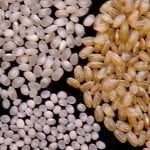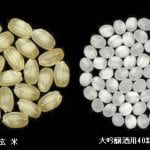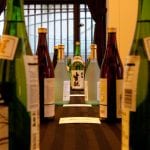The Verdict: More Milling is NOT unequivocally better!
 So, it’s official. The milling wars are over.
So, it’s official. The milling wars are over.
In the past few decades, we have seen increasingly frequent appearances on the market of sake made with rice that has been milled further and further. Well, they did it: this has been taken to the absolute extreme degree to which it could be taken.
Readers certainly recall that rice is milled to remove fat and protein, and that the more this is done, the cleaner and more refined the final sake can be. And readers surely also recall that the term referring to the milling rate is the seimai-buai, and that the number expressed refers to the percentage of rice that remains after milling. And lastly, surely we all recall that the various grades of rice are most visibly defined by that seimai-buai; the more the rice is milled, i.e. the lower the number, the higher the technical grade.
Legally, a brewer has no need to go beyond 50 percent. That will qualify the resulting sake as a daiginjo, and there is nothing higher, at least in terms of legal classifications. But as milling technology and brewing technology advanced in the 1970s and beyond, naturally enough a few brewers wanted to push that envelope for any one of several reasons.
Why would they want to do that? Because – make no mistake – more milling does make a difference, but only to a point. The more one mills before brewing the more elegant and refined the resulting sake will be.
Elegance and refinement are collectively only one figure of merit in sake. There are many others. Breadth. Depth. Richness. Intensity. Resonance. Weight. They are all valid, loveable aspects of sake, and more milling means less of these. But more milling does mean more challenges, and that has its appeal.
And so push that envelope they did, down to about 35 percent. Soon, that number became the de facto maximum, the line beyond which even the most maniacal brewers felt no gain in going beyond. Until they did.
Eventually one brewer milled to 27, but was largely ignored. Then one took it to 25, with pretty much the same non-result. Then along came Dassai, who milled the rice to make their iconic

Sake rice
“Niwari-sanbu” product (a fancy way of saying 23 percent). From the start, Dassai did what Dassai does well, and daiginjo made with highly milled rice became much more familiar to us all.
In time, of course, some enterprising kuramoto had to push beyond that as well. Soon wesaw a seimai-buai of 18%, then 17%, then 8% and even 7%. (Not sure where those numbers, as targets, actually came from.) There are a couple of brewers that put effort into these things, like Tatenokawa Shuzo of Yamagata (brewers of Tatenokawa) and Niizawa Shuzoten of Miyagi (brewers of Atago no Matsu), but there are others that dabble in it as well.
And then it happened: as reported in the October 2017 issue of this newsletter, the aforementioned Tatenokawa made a sake with a one percent seimai-buai! The product name is Tatenokawa Komyo, and in order to achieve the one percent, the milling machines ran for two and a half months straight! In the end, the rice was milled for a total of about 1800 hours. For a daiginjo milled to 35 percent, this usually takes about 72 to 100 hours.
“OK, well, that’s been done. Let’s move on,” is what most would be content to think. But, of course, it did not stop there.
In the legal definition of the number used to express the seimai-buai, the final number is rounded down. So, for example, a 35 percent seimai-buai could really actually be as much as a 35.9 percent seimai-buai. Astute readers will have already seen where this is going: if a brewer can mill rice down to, say, 0.9%, then that leaves the door open to create a sake made with rice that has a zero percent seimai-buai.
Yep; it exists: a sake made with rice milled down to zero percent of its original size!
 The sake is made by the also aforementioned Niizawa Shuzo in Miyagi, and it redefines “extreme” in sake brewing. The rice was milled for 5297 hours and 34 minutes (that accuracy in reporting is very Japanese!), which is 220 days. That is over seven months of straight milling – compared to three days for most daiginjo, and maybe eight hours for your average junmai-shu. Geezus. The product is called Reikyo, and in English Absolute Zero, and retails for 350,000 yen, or about US$3500 a bottle.
The sake is made by the also aforementioned Niizawa Shuzo in Miyagi, and it redefines “extreme” in sake brewing. The rice was milled for 5297 hours and 34 minutes (that accuracy in reporting is very Japanese!), which is 220 days. That is over seven months of straight milling – compared to three days for most daiginjo, and maybe eight hours for your average junmai-shu. Geezus. The product is called Reikyo, and in English Absolute Zero, and retails for 350,000 yen, or about US$3500 a bottle.
In truth, there is no technical merit to milling down that far. There; I said it. Most would say going beyond 40 percent has no benefit, since by then your have removed all the fat and protein you can, and you begin to eat into the shimpaku, the starch packet in the center. That is porous and fragile, and the rice will break up if you go that far. Also, as you begin to mill away the stuff that would actually give the sake flavor, then things have to be changed in the brewing process to ensure there is actually some flavor in the final sake.
And this, of course, can be done. And it is done, when making sake like that. But some would ask, why? What’s the point? Why not just mill less to begin with?
The answer is, not surprisingly, marketing. Stories sell, and extreme stories sell extremely. It’s something to talk about; it’s newsworthy. People will remember your brand. In that sense, it is brilliant. As the folks at Dassai have said, “we make the 23 to sell more of the 50.” And certainly, it works.
So yes, milling to such extremes as eight, seven, one and zero will demonstrate technical prowess. It will express attention to detail in its extreme. It will state clearly that yes, we can; yes we dare. And yes, we did. But will the sake itself be unequivocally better because of it? No; it will not.
And, at zero percent seimai-buai, you cannot be outdone. Or so you’d think. But never say never in the sake world. The only thing that I can imagine that can happen beyond this would need to incorporate quantum mechanics; like, the rice simultaneously exists and does not exist at a given point in time and space. Don’t put it past the sake world to achieve that! But until the main milling machine companies like Satake or Shin Nakano figure that one out, we are good.
So the seimai-buai war is semi-officially over. Postwar rebuilding will take time, but let us hope that rebuilding includes provisions for recognizing how much more less milling can be. More on that next month.
Please be sure to check out this space at least one more time, next month, where I will address the other side of this issue. I will actually diss the seimai-buai, suggest we are all better paying less attention to more milling and showing what we miss out on by jumping on the highly-milled rice bandwagon. A short spoiler would be, there is so much better sake to drink out there!
~~~~~~~~~~~~~~~~~~~~~~~~~~~~~~~~~~~~~~~~~~~~~~~~~~~~~~~~
Sake Professional Course, September 25-27, in San Francisco
 From Wednesday, September 25 to Friday, September 27, 2019, I will hold the 33rd stateside running of the Sake Professional Course in San Francisco. The content of this intensive sake course will be identical to that of the Sake Professional Course held each January in Japan, with the exception of visiting sake breweries. The course is recognized by the Sake Education Council, and those that complete it will be qualified to take the exam for Certified Sake Specialist, which will be offered on the evening of the last day of the course.
From Wednesday, September 25 to Friday, September 27, 2019, I will hold the 33rd stateside running of the Sake Professional Course in San Francisco. The content of this intensive sake course will be identical to that of the Sake Professional Course held each January in Japan, with the exception of visiting sake breweries. The course is recognized by the Sake Education Council, and those that complete it will be qualified to take the exam for Certified Sake Specialist, which will be offered on the evening of the last day of the course.
The course will be followed the next day by the True Sake “Sake Day” event, for which SPC attendees will receive a discount. Learn more here: Sake Professional Course in San Francisco




